Airmyn
Ermenie 1086 (Domesday Book). "Mouth of the River Aire". River-name + Old Scandinavian mynni. The river-name Aire is possibly from Old Scandinavian eyjar "islands", but may be of Celtic or pre-Celtic origin with a meaning "strongly flowing".
A Dictionary of English Place-Names, Oxford University Press


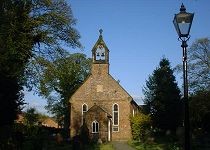
Airmyn is really too large to be a proper village. Its most dominating feature is a clock tower which stands on a bend in the road. This was built in 1866 to celebrate the second Earl of Beverley who paid for the village school to be built.
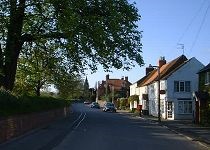
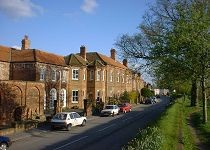
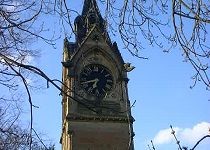
There are excellent views of the River Aire which has a high bank parallel to the main road. The river is very fast flowing and you can see the village of Little Airmyn, on the other side which is many miles away by road via Carlton. In the Middle Ages, Airmyn was a small port and up to the 18th Century, its dead were taken by boat upstream to be buried at Snaith. It was quicker to go by river than by horse and cart.
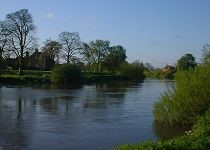
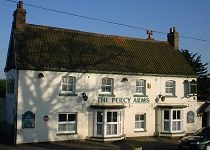
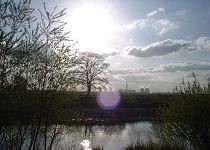
There is a pretty church in the village, originally built in 1318 and extended in 1676. It has a well-kept graveyard which is guarded by a loud dog who lives next door. Each year the village has a gala, based around the modern village hall, with many sporting events.
The Abbey of St. Mary's, York and the first Airmyn
Airmyn was part of the generous endowment - "from Usfleet to Airmine" - that Henry I (1100-1135) gave to the monks of St. Mary's Abbey at York. Substantial ruins of this famous house can still be seen - but perhaps its greatest claim to fame was that it was from this house that a group of monks, who had come to feel that their lifestyle had become too easy-going, left to follow the rule of St. Benedict more strictly and so become the founders of the Cistercian movement in England. At the time of the King's gift, it would seem that Airmyn was without any population. Airmyn (Ermenie) gets its mention in Domesday but the context makes it clear that this is Little Airmyn which is across the river from Airmyn itself.
Mynne is Old Norse for a river mouth, and so with pleasing appropriateness Airmyn simply means "The mouth of the Aire". The actual "meeting of the waters" of Aire and Ouse has - especially at low tide - a look of desolation that may not have been that different when the King gave this uninhabited waste to the Monks of St. Mary's. All mediaeval place names have a great variety of spelling but few can equal Airmyn, Harmyn, Armin, Eyreminne and many, many others. But they all sound much the same.
It was the wealth of St. Mary's that upset the refugees who fled to the wilderness that was to become Fountains Abbey. And though some may well have come from that grasping usury that gives the Abbot of St. Mary's a villainous role in the earliest ballads of Robin Hood, the main source was the skilful exploitation of their possessions. For just as Selby Abbey developed William the Conqueror's gift of Rawcliffe to found a port on the still-navigable Aire, so St. Mary's, York developed Henry I's gift of Airmyn to found a port nearer the mouth of the river with somewhat deeper water than Rawcliffe. As they were only two miles apart and served the same hinterland they must have been in cut-throat competition from the beginning.
The exact date of the founding of Airmyn is unknown. That we do know it within a few years is the result of a dispute between the inhabitants of Airmyn and their landlord in 1253. The "men of Ermine" complained at their alleged exploitation by St. Mary's, York. They wanted to return to the "ancient customs". Very robustly the Abbot told the Court that was dealing with this that there were no ancient customs for "King Henry the King's (Henry III) grandfather gave to his Church of St. Mary, Usefleet and Ermine and that there was no town there until the Abbot's predecessors, after the said gift founded the town there". The "men of Ermine" stubbornly maintained "that at the time of the said gift there was a town there" but the Court did not believe them.
With the foundation of the Port went the foundation of a Ferry too. This could have been "private enterprise" by a group of inhabitants, for later we discover that "Richard, son of William de Newsom, Clerk, gave to the priory of Drax a sixth part of the ferry of Armin which was given to him by Adam, son of Adam de Armin". (On a mediaeval "Monopoly" board, "ferries" would take the place of railway stations as a reliable but modest source of income). This Ferry has the unique distinction of still being in use, though alas, no longer available to the general public.
This "new town" Airmin seems to have had only a modest success. For the Poll Tax of 1379 "Harmyn" paid £1/14/-. compared to "Rawcliffe's" £2/8/8. And the ferry was already established by then for both John Hayll (with Margaret his wife) and John Muram (his wife was called Cecilia) were described as "Ferryman" and taxed at 6d instead of the basic 4d. In 1318 there had been a new clamour from the "men of Ermine". They complained strongly to the Archbishop of York that their spiritual welfare was being neglected because they had no Chapel and "many died without confession". The Archbishop, clearly sympathetic to their grievances, failed to point out that there were Chapels at both Rawcliffe and Hook (not to mention Snaith), and instead "wrote to the Abbot and Convent of Selby, letters exhortatory for dedicating the Chapel of Armin". We don't know what the Abbot's response was but we do know that eventually a Chapel was built and the careful account given of it in 1546 by the King's investigators into Chantry Chapels hints at what the Abbot said two hundred years earlier! "The Chapell of Armyn ys erected by the towneship of Armyn". The incumbent is Thomas Ben but he has only 11 shillings "assigned for his levinge… and the rest of his levinge he hath of the devotion of the inhabitants of the same towne for sainge masse in the said chapel". Clearly the Abbot of Selby must have said "Yes, you can have a Chapel and a Chaplain - so long as you pay for them yourselves". In this Chapel "all sacraments" were "mynystred, save bureinge". The need for it was that it was "distant from their paroch church (Snaith) 11 miles and in winter and wete seasons ther can no man passe betwixt". That one of the bells in Airmyn Chapel today is dated 1375 means that this first Chapel must have been built by then.
What happened next isn't clear. St. Mary's, York was dissolved in 1539 and its estates went to the Crown. In 1540 the "Manor of Armin" was purchased from the Crown by Sir G. Clifton and the deed of sale listing the buildings of the Manor doesn't mention the Chapel. Was this the whole of Airmyn in 1540? Probably. But what of the Chapel? Hook, Carlton and Rawcliffe were specifically excluded from the provisions of the Chantry Acts that should have closed them. But nothing is said of Airmyn. Yet it survived. And the years after 1600 were not without incident! In 1600 poor William Myers fell foul of the Snaith Peculiar Court for crying "Yowle in Airmyn Church". The following year the Churchwardens of Airmyn were in trouble and ordered "to repair the roof of the Chapel, provide a bible and Common prayer boke, repaire the stalls and get a cover for the font". By 1635 troubles at Airmin reached a National Court for "the Commissioners of Causes Ecclesiastical" (Archbishop Laud's hated instrument for bringing order to the Church) fined Thos. Brown of the parish of Armin "for laying violent hands on Wm. Tuck, clerk, Minister of God's word and saying that he would get him in the stocks". The most likely explanation is that in the years after 1550 the Chapel had become disused and neglected. In 1601, as part of the "Church" revival that marked the end of Elizabeth's reign (and led to the re-endowment of the Vicarage of Snaith), an attempt was made to bring it back into use. But this seems to have failed for when, later on in the century in 1674, the new growing port of Airmyn needed a church, we are told that the old building is "quite out of repaire".
The Smithsons and the second Airmyn
In 1656 Hugh Smithson of Hull bought Airmyn and a new age began. It would seem likely that he did so with the intention of developing it as a port. Certainly, under this new leadership, and with some co-operation with the merchants responsible for the Aire & Calder Navigation, Airmyn had a century of commercial prosperity. In 1744 land was acquired by the Aire & Calder Navigation who built warehouses, wharves and cranes. A regular coasting service began to London in 1758. By 1765 ships up to 100 tons were being built at Airmyn. Airmyn was also the place for moving cargoes from sea-going vessels into craft more suitable for working up river. From 1758 to 1786 one of the principal undertakers of the Aire & Calder Navigation lived in Airmyn Hall.
But two new canals proved fatal to Airmyn. First in 1778 the opening of the Leeds-Selby canal made the Ouse, instead of the Aire, the best way of trading with the West Riding manufacturing towns. Then in 1824 the building of the Goole-Knottingley canal, with its development of the Port of Goole, ended the ambitions of all the more inland ports.
The Church we have today is a surviving witness to Airmyn's 18th Century prosperity. It was built in 1676 and that this was an initiative of Anthony Smithson (son of the first Sir Hugh) is still shown by the fact that his Arms adorn the West End. There is a mystery here. For Airmyn Church as we have it is not what we expect a 1676 church to be like. The bell turret and the porch were added in 1858 and the new chancel built in 1884. My guess is that in 1858 changes were made to the ceiling and the windows to make it look more like what - by then - everybody thought a proper church should look like!
Airmyn Hall stands close to the river and as it is now in multiple ownership it is not instantly recognizable as the "big house". But it seems likely that it was built by the first Smithson and so is the house of a great merchant built near to his wharves. Its grounds stretch (or rather stretched) with its 19 acres of Park a long way towards Goole. Now it is the back that faces the river and from the front it looks very much the traditional great house.
So astonishing is the Smithson story - and so closely linked to the history of Airmyn - that it needs to be briefly related. The Smithsons of Airmyn flourished and soon there were two prosperous families - that of the elder son living in London and owning Airmyn, and that of the younger son "of Hull and London". It was Sir Hugh Smithson, the 4th Baronet, who fell in love with Elizabeth Seymour, the young, beautiful and rich daughter of the Earl of Somerset. Surprisingly this "mesalliance" between the bluest of blue blood and the "noveau riche" Baronet had the approval of both the lady in question and the King himself (George II), and so in 1740 they were married. The newly wedded couple went to visit their aged relative (confusingly also called Hugh Smithson) who, having inherited the Airmyn estate, was described as being of "Tottenham and Armin". He was so charmed by the newly married couple that, being childless himself, he made his young cousin his heir and very shortly after (he was over 80) died. The newly married couple were able to spend part of their honeymoon on their newly acquired estates at Airmyn. The 4th Baronet was now a very wealthy man - but his fairy-tale good fortune had not yet ended. For only four years later his wife's brother George, who was heir to the Percy lands titles and fortune died of smallpox. The inheritance proved a complex legal affair. But in the end, though Lady Elizabeth Smithson could inherit the Barony of Percy, it was her father, the Earl of Somerset, who was created Earl of Northumberland with it specified that the title was to go to Sir Hugh Smithson and his children. The old Earl died and Sir Hugh and the Lady Elizabeth became Earl and Countess of Northumberland. The story was completed in 1766 when the fortunate couple - and from all accounts their marriage was one of great happiness - became the first Duke and Duchess of Northumberland.
Airmyn has now become part of the Percy Yorkshire estates. At some point the decision was taken to separate these from the Northumbrian estates for the benefit of a younger son of the 1st Duke who in 1790 was created Earl of Beverley. After his death in 1830 his title and estates (including Airmyn) were inherited by his son George, the 2nd Earl of Beverley (and cousin to the 3rd and 4th Dukes of Northumberland).
The Percys and the third Airmyn: an Estate Village
This piece of family history has taken us into the 19 th Century. The days of the Port of Airmyn have become a memory. But, as for a number of Yorkshire villages, they were in many ways good years in which benevolent Landlordism flourished. Airmyn school is one sign of this, for it was built in 1834 and remains in use today. The Clock Tower is another. For in 1865 George Percy, Earl of Beverley and Lord of the Manor of Airmyn, inherited the Duchy of Northumberland from his cousin and left Yorkshire for Alnwick. Perhaps not inappropriately - for he was aged 85 - his tenants clearly thought this the equivalent of death and resolved upon the erection of a suitable but useful cenotaph.
A bridge that linked "Little" and "Great" Airmyn would have been useful, but the cost was prohibitive. They settled on a Clock! The cost was £700, the designer H.J. Lockwood, and all was complete by 1868 (but alas the Duke had died in 1867, two years after his accession, and so he never saw it). Legend has it that it was the people of Little Airmyn who were (for obvious reasons) keenest on the bridge and when their proposals were turned down they refused to support the venture. In revenge it is said, the Clock was carefully designed with only three faces so that those who lived at Little Airmyn didn"t benefit from that for which they hadn"t paid! It is a very "Yorkshire" story but, sadly, appears not to be true: a bridge would have cost ten times as much as the Tower, the Clock faces can be seen from Little Airmyn, and anyhow Towers were fashionable in 1865. Of the same date is the great tower on the Yorkshire Wolds, near Sledmere, built by his tenants in gratitude for the life and work of their landlord Sir Tatton Sykes.
So the Airmyn Clock Tower - still standing well over a century later - commemorates George Percy, 2nd Earl of Beverley, 5th Duke of Northumberland and descendant of that Sir Hugh Smithson who purchased the Airmyn estate in 1656. But yet again Airmyn was not swallowed up into the Percy's Northumbrian estates. This time it was given to the Earl of Beverley's daughter who had married a son of that Bishop Heber of Calcutta who is today chiefly famous for the hymn "Holy, Holy, Holy, Lord God Almighty". The couple took the name of Heber-Percy, and though they took an interest in their Airmyn estates they continued to live in the Heber ancestral home at Hodnet in Shropshire. They were visitors to Airmyn only. A further family arrangement worked to the advantage of Airmyn. For in 1874, the Hoods came to live in Airmyn Hall as the Agents of the Heber-Percys and remained there until 1911. This was certainly the Hall's Golden Age. Mrs Hood was a Heber-Percy daughter (and so a grand-daughter of the "Clock" Earl of Beverley). Her husband was a descendant of Lord Hood, Nelson's Admiral. For the only time in its history Airmyn had a "resident squire". With "squire", Church and School working together, and a number of strong personalities involved, its likely to be a matter of opinion whether we see this as a "golden age" or a time of tyranny.
It certainly improved the water supply. Since Airmyn began the river had been the only source of water. At some point two pumps had been placed on the river's edge and this must have made the fetching of water slightly less perilous. But towards the end of the 19 th Century, as the river became increasingly polluted (there had been a cholera epidemic in Goole and Hook in 1832), Mr Heber-Percy saw to it that there was a piped water supply of spring water into the village. Of course it didn't go into the houses but there were four stand-pipes and Airmyn became the first village in the area to have piped water.
Church life was strong and Airmyn was famous for its Church Choir. Though not all of Airmyn's Vicars have been popular: Mr Millner in his 70s was a recluse and Mr Stratton is said to have emptied the church with his high-church ways.
In the 1880s this rural idyll began to be threatened by the onward march of Goole. In 1891 a daughter church of Airmyn was built in Goole for the new houses, and then Airmyn had a succession of Curates.
A change of parish boundaries in 1905 ended this experiment and St. Paul's, Goole replaced St. Mary's, Airmyn. The 1914 War, as so often elsewhere, came to represent the end of an age. The Hoods left in 1911 and the Heber-Percys put the Airmyn estate up for sale in 1920 and since then many different people have owned houses and farms in the village. So little interest had the family in the village with which their ancestors had been so closely linked for nearly three hundred years, that on being asked to help with the repair of the Clock Tower in 1947, they advocated its demolition. The advowson of the living was sold to the Church Society, the most fervent of the Evangelical Patronage Trusts.
Airmyn 1920 onwards
Airmyn today faces two threats: steadily the River rises higher (or it may be that with the rest of the east coast Airmyn itself is getting lower) and the threat from high tides demands steadily higher defences. Even without the "greenhouse effect" this causes problems and those who remember Airmyn in the old days regret the formidable wall that now separates the village from the river. The second problem comes from the steady advance of Goole! Again, as in 1890, there is a considerable population that lives within the parish boundaries and yet is really part of Goole. But if each time this happens the parish boundaries are altered what eventually will be left for Airmyn?
Despite this double threat Airmyn must have a strong claim to be one of the most attractive villages in the Diocese of Sheffield. It is well worth a visit if only to see the Clock Tower which survived the crisis of 1947, and having been given to Goole Rural District Council (may it rest in peace) was restored in 1952 and is now surrounded by an attractive garden. And then, as you walk along the river bank, you see a village that is still a village: with Shop, Post Office, Pub, School, Church and half a vicar: and a Ferry. Long may it flourish!
Rivers, Rectors and Abbots, David Lunn - Bishop of Sheffield, 1990
Postcards
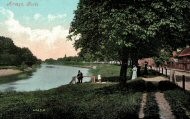

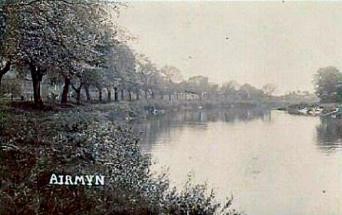

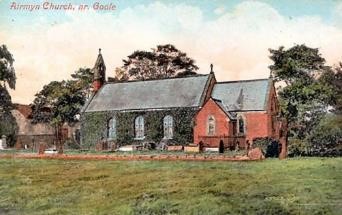
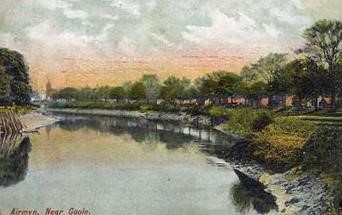

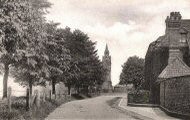
Visitor Comments
Posted by Jonathan on 19/09/2007
Around 1892, my wife's great(x3)-grandfather, William Eccles, was the landlord of The Percy Arms. He was also the ferryman somewhere in that area for the previous 40 years.
Posted by Richard on 11/09/2020
My great-great-uncle William Eccles and his wife were proprietors of the Percy Arms and the ferry in the mid-19th Century. His wife Hannah Eccles (nee Perkins) was my direct ancestor as my great aunt. It is interesting to hear of what life was like before the bridge was like.
Posted by Robert on 26/01/2008
I heard somewhere that H.J. Lockwood, the designer of Airmyn clock tower as mentioned above, was Henry Lockwood of architects Lockwood and Mawson who designed Bradford Town Hall and Saltaire. Does anyone know whether this is indeed correct?
Posted by CB on 24/06/2008
I lived in the village up until I was around ten years old. Woodview was the street.
Posted by Kate on 04/10/2008
I lived in Woodview! Best street in the village!
Posted by George on 19/09/2008
I am a Smithson, being a descendant of many Smithsons from the Watton area of East Yorks, and have passed through Airmyn many times on the way to the coast, before the M62 was built. We used to nip through Airmyn and have looked in awe at the church clock.
Posted by Ann on 12/10/2008
I lived in the village for the first ten years of my life from 1953. I lived at 104 High Street with our garden backing onto the bankside. It was wonderful and I remember so much of those times. I have since looked into my family history and found that the village had many of my family members (on both sides) in the 19th Century, including the FIELDER and BRISTOW family. Also the ROBERTS family who appeared to be bridge-keepers on the river in Rawcliffe.
Posted by Armin on 29/10/2008
An ancestor of mine was Anne WILSON, married Robert GARRET (b. 1869). One of his descendants, also a Robert, was ferryman too, circa 1820 when he married a Rachel of Brind(?) until his death in 1885 from memory. Any takers for this family history search? Thanks.
Posted by Christine on 14/11/2008
Robert Garratt and Ann Wilson are my great(x4)-grandparents. According to my records, Robert Garratt's mother was called Elizabeth. His father was also called Robert Garratt and was born in Hemingborough, Yorks.
Ann Wilson's mother was called Ann Low (b. about 1733 in Yorkshire). Her father was called George Wilson (b. about 1733 in Yorkshire).
Posted by Armin on 14/11/2008
This is wonderful stuff. We are talking about the same folks. I got back from Beverley local archives yesterday with more notes on the village in its days as Earl of Beverley's estate, with rentals of properties and so forth. My real interest is in resurrecting the lives of these ancestors, so your knowledge about Ann(e) fills in something I had not yet done. Know she was daughter of George and Ann Wilson, and I found odd mentions of an Ann Wilson 1666 a widow with three Tofts, and a mention of a John Wilson. Look forward to learning more from you.
I am a Garrett, our spelling of it, but have found that Robert's father and mother, the Robert and Elizabeth you mention, of Hemingbrough were still alive when their granddaughter Hannah was born 1802 I think, from memory, and am about to try and find out more of their history, from a visit to Hemingbrough records at York's Borthwick Institute. If you have more background that would be appreciated and might save me a visit.
I come from Robert, down to what I believe was a son, not found in records yet, John. I guess he was born 1794 after the twins who died. Then his son Thomas, to his son John, and his son Fred, my grandfather the butcher at Goole, to his son Fred Clifford, my dad.
Posted by Ursula on 13/03/2009
A stroke of luck finding this website, as I am trying to research my family's history with not very good luck as I live in Canada and all my family history lies in England. I stayed with my uncle Clifford who owned a butchers shop and had two daughters, Sally and Enid, when I was a child of eight years old, for a brief period while in England.
Posted by Armin on 14/03/2009
Ursula, the wonders of the world wide web! I remember you well, and as luck would have it have been working on the Cook family. Not got around to placing your dad Jack in the scheme of things, yet, but there is another Cook descendant also researching the various strands of the family. Have sent him a copy of your enquiry.
Posted by Julie on 08/09/2010
Have just visited this site and found a message from the granddaughter of Fred Garrett the butcher from Goole. My grandma was Fred's youngest sister Olive and I too am researching the Garrett family history.
Posted by Armin on 30/09/2010
The web must work wonders! The link with Julie has resulted in me being able to help her get in touch with the other side of the family, a cousin who also found me on this webpage.
Posted by Adam on 06/01/2009
My mum was born in 1921 and grew up in Airmyn. Does anyone remember Patricia (Pat) RICHARDSON or her sisters (Eileen and Mary), brothers (David, Alec and Mick) or perhaps my grandfather Harry Richardson? All information, however trivial, very gratefully received, as I am trying to fill in the blanks for my kids about a grandmother and a Yorkshire family history that they never knew. Thanks.
Posted by Armin on 12/01/2009
I believe they were coal merchants - David Galloway's "Airmyn in Days Gone By" (one of his three volumes pictorial history) refers to the family living in the village. Probably out of print now, but perhaps available second-hand, online.
Posted by Armin on 12/01/2009
Checked Galloway at the library while there today. Vol. 3 has two entries for Harry R. - one about his boyhood on p.16, the other a family portrait outdoors in 1919.
Joseph R. and his wife and first born son were living at Richard Cooper Street, Goole, in 1891 - early in their marriage. Street now under threat of demolition. Hope this helps you get started on family history!
Posted by John on 26/02/2011
Harry Richardson was a coal merchant and he was twice married. His second wife was Kathleen Costello and they had three children. There were also several children from the first marriage. The family lived at No. 61 or 91 High Street. I was a frequent visitor to Airmyn as Kathleen's mother virtually raised me when my own mother died in 1943 at Wetherby.
Kathleen's own mother was A.L. May Costello (nee Farmery - a family that has seafaring connections). The names Alec and David ring bells! Sons of the first marriage.
I haven't been to Airmyn since 1969 and there will have been changes no doubt.
Posted by Fox on 16/03/2009
Could anyone help? I'm looking to where the railway ran in Aimyn. Thanks.
Posted by Barrie on 24/11/2009
The station for Airmyn was located about two miles away and the stationmaster's house and one or two others around it are still there. They were all owned by the North Eastern Railway. The station was called "Rawcliffe and Airmyn" or "Airmyn and Rawcliffe", I can't remember which but have documents which would tell us. It was on the Goole to Selby line which originally was to provide a direct link from Goole to Leeds. It provided an alternative route from Leeds to Hull via Goole if any problems arose in the Selby area. There was a service of four or five trains a day between Goole and Selby and connections at Selby to Leeds. There were actually two stations at Rawcliffe and the other station, still open, was called Rawcliffe Bridge, it was located near to the canal and in recent times renamed Rawcliffe.
I think that the estate called the Crossings probably took its name from the bridle path that went into Goole.
Posted by Robert on 25/11/2009
Originally "Airmyn and Rawcliffe", renamed "Airmyn" in 1961. See "Railway Memories No. 14", Selby and Goole by Stephen Chapman pages 65-70 which includes a picture of this station, and also covers other parts of the line.
Posted by Richard on 31/12/2009
The wonders of the web! My wife and I just typed Airmyn in a search box and we ended up here. We live in Australia and Helen, my wife, comes from Airmyn. Her parents, Syd and Lily King still live there. Does anyone know them? Thanks.
Posted by Maureen on 04/01/2010
I was at school with your wife Helen and had just been looking at the old school photos on the school memories. My maiden name was Woolass and I am on the left, second row with Dog Watson the form teacher. I married Dennis Raywood, whose uncle was Harold King, brother to Syd King. Small world!
Posted by Sue on 11/01/2010
I am researching my family tree. My grandmother on my father's side came from Airmyn. Her name was Lily SWEETING, her father was William Sweeting (b. 1870). His father was John Sweeting (b. 1830), a blacksmith in Airmyn. Mother Mary nee Coneyswoth from Newport.
If anyone could shed some light or help I would be more than grateful. Thanks.
Posted by Colin on 09/05/2011
Sweeting is my wife's family.
William Sweeting (b. 1788) a blacksmith married Esther Emmanuell (26/04/1813 in Drax).
John Sweeting (b. 3 Jan 1830) a blacksmith married Mary Conesyworth (12/1851 in Beverley). William Sweeting (b. 1869) married Selena Lee (1890 in Howden).
Lily Sweeting (b. 1897 in Gilberdyke) married Enoch Murr (25/08/1918 in Pocklington).
Posted by Carl on 20/01/2010
The first time I ever saw Airmyn was at Christmastime, 1962. We were visiting my mother's first cousins in Doncaster, Airmyn, Goole, and other places. This was a revelation to me, since my mother's father had immigrated to America in the late-1890s, and, although I never knew him (he was killed by lightning in 1903), tales of the relatives in England abounded in the family.
Posted by Krysia on 16/02/2010
I am trying to trace my great-grandmother's family that came from the Goole area. My great-grandmother's name was Ada Ann HEARN. She had sisters named Clara, Nelly, Amy, Amelia and brothers Amos, Robert and John Shallom.
My great-grandmother's father was John Hearn and he worked as a railway horse driver. I am not sure if this would have been in Airmyn. My great-grandmother herself, married Claude Jackson, who worked at a timber merchant, also near Goole, so not sure if in Airmyn. She was a teacher. One of the sisters, Amelia married a Sidney Griffin.
I wonder if anyone knows anything about any of them, or where they could have worked? Thanks.
Posted by Trev on 15/07/2010
Can anyone help? My wife and I did our courting in Goole in 1960/61. We often walked from Boothferry Road to Airmyn on a path just past West Park, then through Airmyn to Boothferry Bridge and back. Can anyone remember a cafe in Airmyn at that time? I think it was run by a French lady. My wife can't recall it - so is my old brain losing it or not? Thanks.
Posted by Armin on 30/09/2010
Don't remember one really, but memory suggests there was a kiosk once upon a time that served "take aways" - too modern a term. Is was at the Old Hall, but that would have been before 1960. There was a garage place near end of bungalows I think too.
The only French-speaking lady I could suggest was Mrs Glew, who I believe was the wife of Glew the furnisher in Aire Street. A customer of my dad's. Think she may have been a Belgian national before her marriage. Think her first name was Marcelle?
But can't recall a cafe in the village. Only cafe we visited as children in 1940s/1950s was Riverside Cafe at foot (Howden side) of Boothferry Bridge.
Posted by Robert on 30/09/2010
Yes I remember the cafe in Airmyn run by a French woman, around 1966/67.
Posted by Armin on 03/10/2010
Good! We can't all be ga ga. I tend to think I am imagining it until someone corroborates these things. Do you remember where your cafe might have been?
Posted by Trev on 06/10/2010
My wife still can't remember it but at least you have convinced her that I'm not losing it yet. As you came out of the bridleway, it was on the right towards Boothferry, only a little way along.
Posted by Ann on 15/11/2010
There was a cafe in the late-1960s at least. It was later one of the first buildings as you entered Airmyn from the Boothferry Bridge side of the village. There was a jukebox - I remember visiting with a friend and buying a coke and choosing Tom Jones, "Green Green Grass of Home", on the jukebox. I think it was transformed back into a bungalow, but I'm not sure.
Posted by Keith on 27/02/2011
The cafe in Airmyn was the first bungalow on the left coming from Boothferry Bridge. It also sold petrol and was the only place open early morning to fill up. It's now back to a residential dwelling.
Posted by Celia on 01/03/2011
Mrs Glew was French speaking - and yes - I believe Belgian. She lived in a flat in Hook Hall towards the end of her life and was a regular visitor to our home in Hook.
Posted by Martin on 19/11/2011
Regarding the cafe in Airmyn with the French speaking lady. This lady was Mrs Alice Alfreda Jeanne Garner who was born in France and married a Goole man Jim Garner in 1919. The cafe was called the Bridge Cafe. This information has come from her son who still lives in the area and remembers it well.
Posted by Phil on 11/04/2016
I lived on Chestnut Avenue in the 1960s and yes there was a cafe and petrol station at the last bungalow going out of the village. It belonged to the Smith's. Mrs Smith was indeed French and the family came from South Africa. Their son went to Drax Grammar School.
Posted by Val on 02/12/2010
Found this site whilst trying to research my family tree. Only recently found out my family had connections with Airmyn and I wonder if anyone has come across the family name MASKILL? I have found a William who was a ship's carpenter who married in Airmyn about 1792 to an Anne Fox. Wonder if anyone else has Maskill's in their tree?
Posted by Nicola on 22/07/2013
My great(x4)-grandfather was called William Maskill. It links that he was a ship's carpenter from what I know. He owned a ship in the mid-1800s. I have links somehow with Airmyn as it's where my other grandfather William Holdsworth was born. William Maskill and William Holdsworth were joint boat owners who owned a schooner.
Posted by Corby on 22/07/2013
If you Google "John Wray Burton Stather ship builder", you may see your two ancestors mentioned. The Schooner in question was named WILLIAM MASKELL, built in 1858 for Goole coastal trade.
Posted by Val on 22/02/2014
Still researching the Maskills. Thanks for the info re the schooner. Guess this must be our man! Have got a bit further back - I think William's dad was a Thomas Maskell, shoemaker from Howden, possibly born 1740ish and father to a Sarah (b. 1767) which would fit with William's age too. Can't manage to find the direct link though. Are you aware of previous connection to Howden?
Also William had a brother Thomas at Thorne, licensee at the White Hart. He is one of my other great-great-grandparents due to cousins marrying. Thanks for your update.
Posted by Corby on 23/02/2014
According to Howden Parish Registers, in the period you mentioned there were two Maskel families.
Richard Maskel married Ann Hart in 1735 Both of Barnhill Hall? Their offspring were Elizabeth 1737 Abraham 1743 and Richard 1745.
Robert Maskel had William 1740, Mary 1737. As there is no previous mention of Robert I presumed he came from out of the area.
Only one Maskel mentioned in the Minster Graveyard. William Maskel died 1759 aged 27
Hope that this may help.
Posted by Val on 01/03/2014
Thank you for the information. I had also been trying the Howden Parish registers with much the same result. What is pushing me in the direction of Howden is that on William's marriage entry in the Airmyn register, his father is shown as Thomas, shoemaker. From what I have seen elsewhere there appear to have been generations of Maskill shoemakers in Howden up to the mid-1800s when I guess they started making factory footwear. There also appear to be some family connections to North Duffield.
Posted by Robert on 01/03/2014
Elizabeth Maskill married Thomas "Wetherall" (normally Wetherell) farmer and son of Mark "Wetherall", labourer, at Airmyn on 31st May 1849. They moved to North Duffield. Three children: Emily Jane Wetherell (b. 1850), William Maskill Wetherell (b. 1853) - he was elusive when I last looked, but may be easier now, Betsey Wetherell (1854-1854).
Emily Jane became Tallents then Turton, second wife of Thomas Coates Turton who was a dentist in Belgravia, Goole, and first chair of the governors of Goole Secondary (later Grammar) school. His son from his previous marriage took over as the dentist and my dad remembered Mr Turton using a pedal-operated dental drill. This practice was later Bowles.
But to return to Elizabeth Maskill, the Goole and Marshland Gazette announced the death aged 27 at North Duffield on 27 August 1854 of Elizabeth, wife of Mr T. Wetherill and third daughter of Mr W. Maskill, formerly of Airmyn.
Thomas Wetherell remarried Eliza Nappey and one of their sons Charles Edwin Wetherell founded Wetherells department store in Selby.
Posted by Corby on 02/03/2014
I have a Wetherell on my tree. Tom Smith Wetherell (b. 1857 in Rawcliffe). Married in Goole, Harriett A. Moore 1879 in 1881 living at 41 Victoria Street. Could you tell me where he is placed in the Wetherill family? Harriet being daughter of my great-aunt Olive nee Wright. Tom had a son Ralph M. who became a mariner. This whole family moved to Canada.
Posted by Robert on 06/03/2014
I replied to Corby directly, basically that a bastardy document in Beverley Archives shows that Thomas Smith Wetherell was the son of Ann Wetherell and George Smith of Potter Grange. This was probably the George Smith that later shot a servant and was tried for murder in 1862.
Posted by Val on 07/03/2014
Many thanks for the update on Elizabeth Maskill. This is great stuff and I will add to the tree, I had no knowledge of her previously as the girls always seen difficult to track due to name changes. From the dates I believe she must have been the daughter of William Junior (b. 1793). This may explain the North Duffield connection as William Junior appears to have moved to North Duffield where he was a blacksmith. Very much appreciated.
Posted by Carl on 11/06/2012
I found this website more-or-less by accident. When I saw the photo of St. David's, it reminded me that my (great?)-great-grandfather Thomas (Herbert) Simms is buried here. My second cousin, David Galloway, has lived in Airmyn all his life.
Posted by Trev on 31/07/2012
My mum was telling me today that when she went to school at Alexander Street in Goole (1911-1920) one of her teachers called Miss Precious used to walk home with her then walk all the way to Airmyn where she lived with her parents who kept a pub there. Can anyone tell me the name of pub as mum can't remember it? Mum is nearly 106 years old and still doing well. Thanks.
Posted by Caroline on 27/04/2016
Still doing my family tree and found out that my great-great-grandfather Thomas Brooksbank was a ferryman at Howdendyke to Hook. Apparently he drowned on 10 July 1873. Can anyone shed any light on this? He was only 28 years old. Thanks.
Posted by Christine on 28/04/2016
About 130 years ago, four of my distant cousins were drowned by their boat capsizing in the River Aire/Ouse, after having a pint in the Old Percy Arms, and not heeding warnings by other customers, regarding the oagre at that particular time of the year (10 August 1884). Their boat capsized and nobody on the embankment were able to swim, and the police couldn't reach them, so sadly their lives were lost, it was a Sunday Evening, The names of the four men, all Durhams: Thomas Durham aged 20; William Durham age 32; Fredimund Durham 18; and their cousin Alfred William Durham age 21, Alfred was local to the area and was a fisherman.
Posted by Frank on 12/06/2017
Are there any descendants of the FOSTER family living in Airmyn? I believe my great-aunt, Ivy Foster nee Harrison, had family living there. Ivy married William Foster in Rawcliffe on 25 February 1924, and at some point they lived in Airmyn for a while at a farm which is no longer standing. They also lived in two places in Goole as well as "Cuckoo Park"(?) in Rawcliffe. Thanks.
Posted by Corby on 13/06/2017
The person that you are looking for is Dennis Foster who lives in what was once the old fish shop on the riverbank. He is related to all who you mentioned and thinks that you may be the son of the Frank he knew.
Posted by Keith on 17/06/2017
Never knew there was a fish shop in Airmyn. We used the bridle path to Airmyn in the 1950s quite a lot (I remember that) but not a fish shop, you learn something every day.
Posted by Corby on 17/06/2017
The fish shop was not there in our time. Dennis was told this when he moved in. Airmyn has changed so much. Does the bridle path still exist?
Posted by Keith on 18/06/2017
There seems to be an entry where the bridle path used to start, just over the motorway bridge. I have often seen vehicles parked as if taking dogs for walks. But whether the path through to Airmyn still exists I don't really know. Possibly someone will throw some light on it.
Posted by Corby on 18/06/2017
You are correct. I have it confirmed by phone. I have only two contacts left in Airmyn now. The other being George Smith, hero of the Russian convoys. He is now 96!
Posted by Goolie Gone on 18/06/2017
For those of us who don't know about George and the Russian convoys would you mind putting us in the picture please?
Posted by Corby on 19/06/2017
Gorge's time in the Royal Navy was on destroyer escort vessels. The first was an aging ex American four stacker GIFT HORSE He then joined HMS ROWLEY, escorting the merchant fleet. Many years later the members of the Royal Navy and Merchant Navy received their just rewards with medals in recognition of this heroic escapade. This was well covered in the Goole Times.
Back to Table of Contents
feedback@goole-on-the-web.org.uk